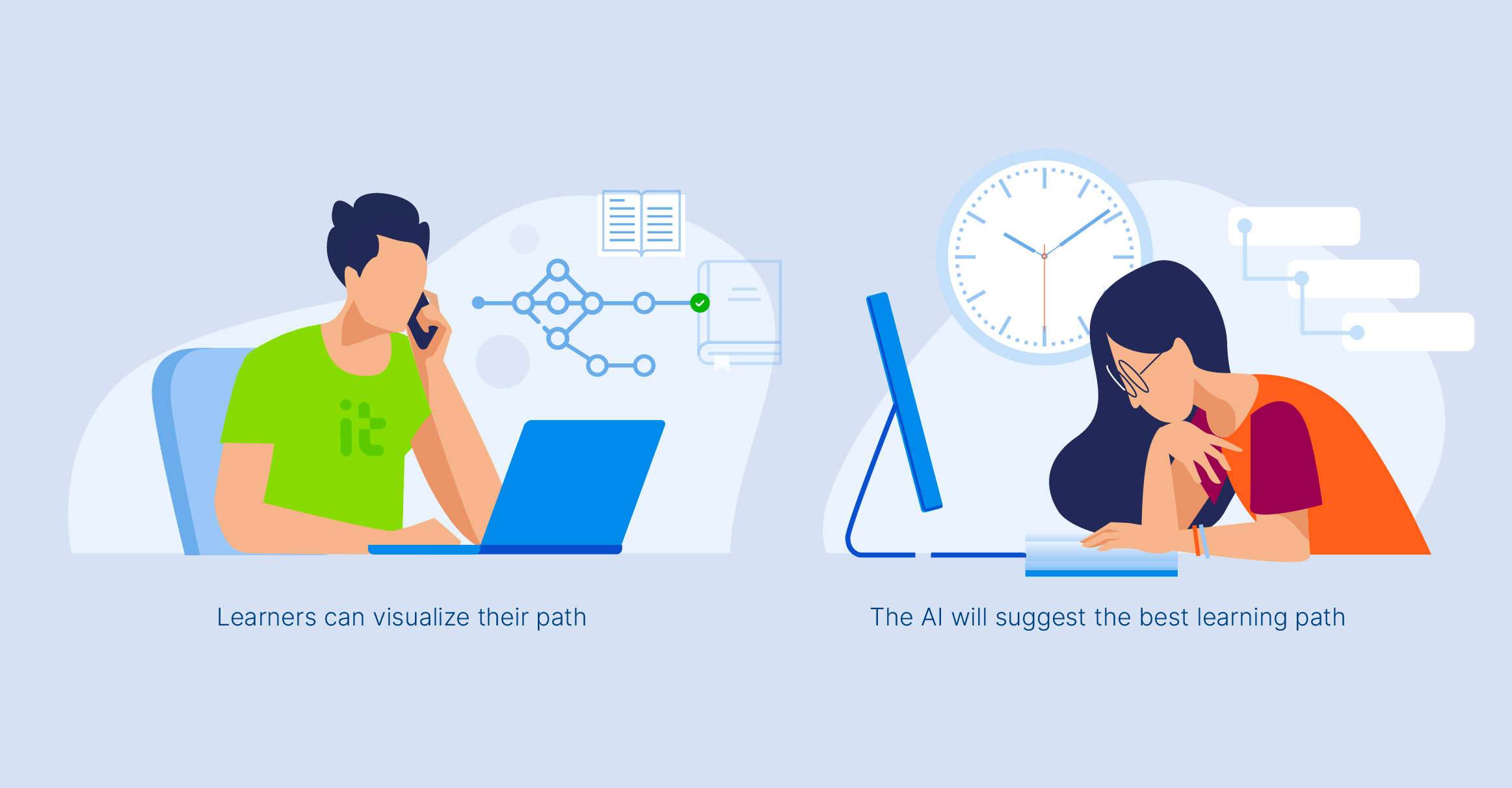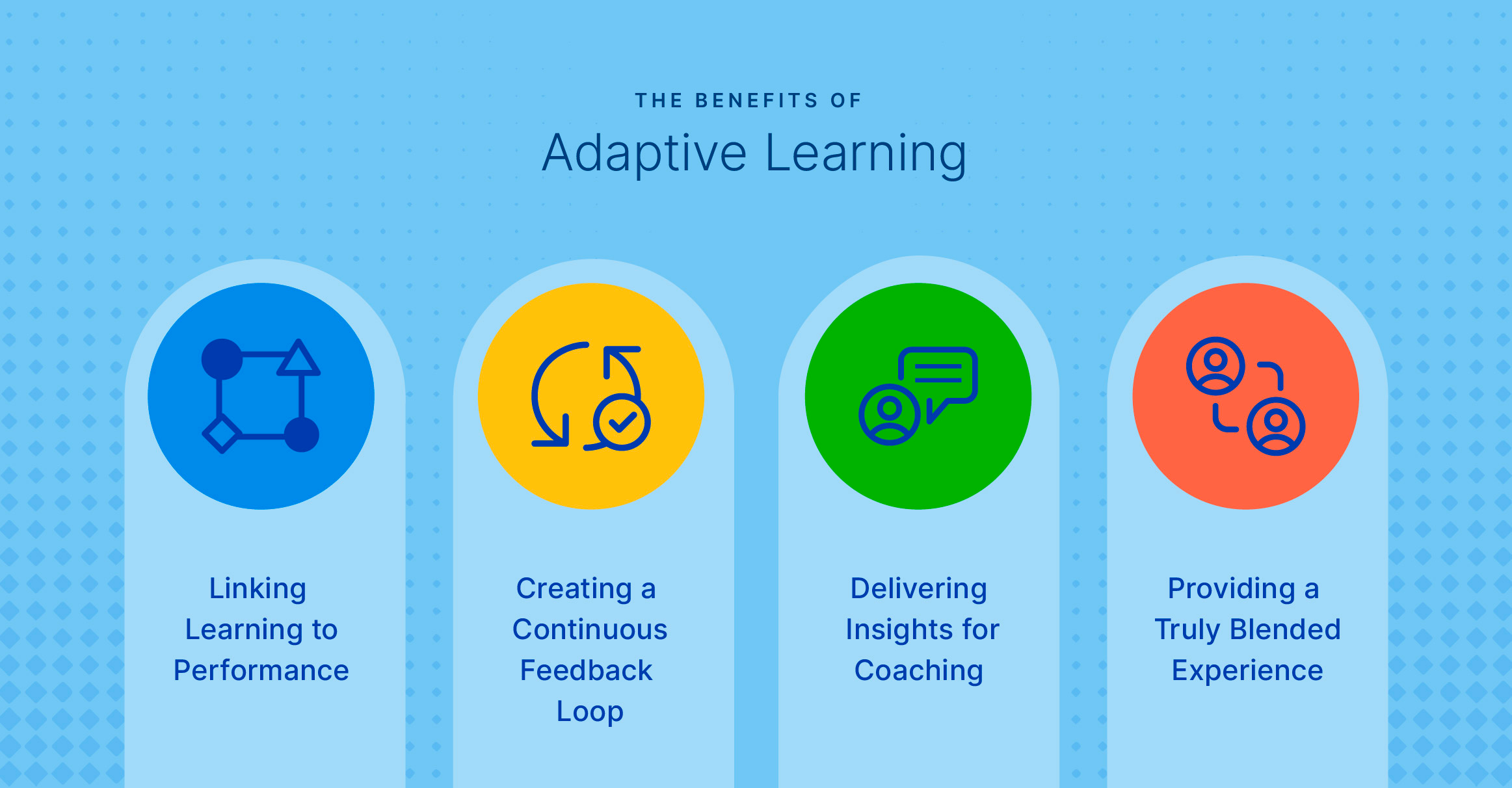Training and learning are constants in today’s workforce. New workers need to get up to speed quickly to find their rhythm, become competent, and perform. Existing workers need to be reskilled and upskilled to stay competitive.
Traditional learning methods tend to be slow and ineffective, wasting precious time and resources. Learners become increasingly demotivated as they encounter learning material that is simply not relevant to them.
An adaptive learning system, by contrast, solves the problems with traditional learning, using the power of AI and machine learning to provide a dynamic, personalized learning experience for each learner.
Learners are constantly assessed on their progress in mastering the required skills in order to automatically adjust the learning pathway in real-time. This lets the AI intelligently adapt and predict the best path forward at every moment of the journey, constantly delivering the most relevant content for each learner’s place in their learning process.
Some of the ways in which adaptive learning technology improves the learning process include:
-
Improving speed to competency
-
Ensuring competency
-
Improving knowledge retention
-
Personalizing to every learner in context
-
Guiding each learner’s journey
-
Optimizing training development and delivery
-
Reducing training maintenance costs
Improving Speed to Competency
Adaptive learning minimizes downtime due to training. This is a vital advantage when every minute spent away from working can have an impact on your company’s bottom line.
The assessment-based approach constantly evaluates what learners know and don’t know, avoiding work on areas of strength and focusing instead on the areas of greatest need.
An individual’s learning history can point to where they have prior knowledge and can speed through material.
Learning focuses on knowledge gaps, minimizing time wasted on already learned material.
Ensuring Competency
Adaptive learning technology both models and measures an individual learner’s core levels of competency. It also helps remediate any gaps detected in their knowledge.
A continuous search for weak areas provides training focused on skill gaps.
Holistic testing makes sure learners understand ideas in relation to the entire knowledge model, not just one lesson.
Improving Knowledge Retention
Without proper reinforcement, learners tend to forget things over time. Adaptive learning uses AI to reinforce knowledge to make sure it can be rapidly recalled when needed, pulling quiz questions from the core content and not requiring a separate microlearning system.
Automatic delivery of knowledge refreshers is built in based on each learner’s unique needs.
Prioritizing support for knowledge important for performance ensures that learners have what they need to carry out their roles.
Personalizing to Every Learner
Learners vary in their knowledge, experience, and readiness. From differences in job role, company department, and division, as well as geography, the learning experience adapts to the context and needs of each learner.

Learning adapts to the learner’s profile, including the learning context, their knowledge proficiency, and their engagement level.
Adaptive learning constantly recalibrates what each learner knows to tailor training to each learner’s needs.
Guiding Each Learner's Journey
Instead of being a linear playlist of courses, an intelligent adaptive learning system acts as a learning GPS guiding the learner on a detailed journey to become competent in the skills laid out in the map. Going beyond a traditional eLearning approach, adaptive learning provides a mix of learning techniques, from self-learning to instructor-led classes, one-to-one coaching sessions, collaborative sessions, and project work coupled with a variety of ways to demonstrate skill mastery.

The pathway then automatically adjusts based on a learner’s demonstrated knowledge as they work across the map, and visualize their progress and where they should focus more attention.
Learners can visualize their path to see their own progress toward learning goals.
The AI will suggest the best learning path while allowing learners agency to choose their exact learning journey.
Optimizing Training Development And Delivery
Adaptive learning gives you the tools and analytics you need to design, deliver, and maintain the knowledge maps and content that adapt to the needs of various learners.
Learning assets become a reusable single source of truth as they are built, maintained, and deployed. This includes knowledge, assessments, and content.
A granular knowledge and content model supports creating bite-sized learning nodes that power the AI to measure mastery and adapt the learning journey.
Intelligent migration of existing content into the system using AI-powered ingestion makes it easy to transform content to be fully adaptive with minimum effort.
Existing content can be linked to in the LMS, LXP, or externally to provide a seamless experience that is rapid to deploy.
Reducing Training Maintenance Costs
Adaptive learning includes integrated content management that allows changes to be made in one place and automatically updated wherever the content is used. Learners can also be prompted automatically to review and sign off on changes whenever the content is updated in skills they have already learned.
Surgical updates can be made quickly and easily based on the improved learning design and structured data model.
Updates are delivered precisely to the learners who need them in the flow of work, saving time and improving performance by avoiding the need to wait for an update class to learn about changes.
How Adaptive Learning Can Also Impact Trainers And Managers
Adaptive learning facilitates benefits for the learner, but also creates huge synergies for trainers and managers, streamlining, automating, and adding insights to the entire learning process, from start to finish.

Realizeit’s platform delivers real-time insights comparing the group’s performance to each learner, allowing managers to find patterns and identify problems. By understanding where people struggle, leaders and mentors can guide productive, personalized discussions toward solutions with less effort.
In this article, we wanted to offer a brief overview of the possibilities of Adaptive Learning. If you would like to dive deeper into additional benefits and more details, check out our full guide here.
.jpg?width=1116&height=582&name=11ways__05_inline5%20(2).jpg)